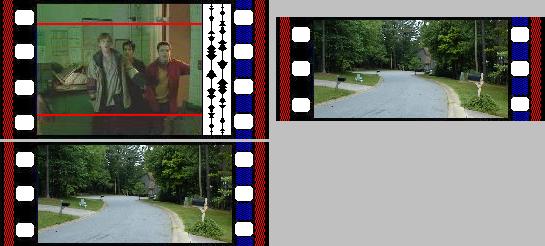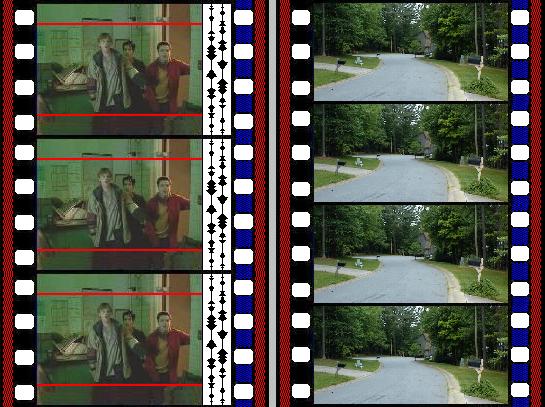MaxiVision
As film formats have changed over time vertical 35mm has remained the most commonly used format of most neighborhood theaters. While things such as sound going from analogue to digital, and anamorphic lenses changing the ratio of the projection screen have come about the method of moving the film through the projector has remained almost the same as it was 100 years ago. 24 frames per second, 4 perf pulldown (which means each frame is 4 sprocket holes tall). A company called MaxiVision hopes to change all of that. They have found what they believe is a way to combine the best of Flat and Scope and than some.
MaxiVision24
One of the biggest complaints against "Flat" movies (which are 1x1.85) is that they waste about 25% of each film frame because all of that area above and below the matte lines is never seen by the audience. As for "Scope" movies (which are 1x2.35), they use the whole film frame and have a wider, more cinematic, picture; but when filming it takes more time and effort to set up the shots because the anamorphic squeeze reduces the film stock's depth-of-field. The people at MaxiVision have come up with what they believe is a solution to both problems. Their format uses regular vertical 35mm film, but each frame is only 3 sprocket holes high. Since "Flat" movies only use that much area of the frame anyway that would
be good enough to shoot in that ratio and use 25% less film than standard 4 pulldown. Since many film makers want a wider image than 1x1.85 they have also come up with a way to make the image wider without using an anamorphic lens. In our modern age most first-run theaters do not use the old 2-channel stereo sound (they use 5.1 or 8 channel
digital surround sound) MaxiVision has taken the optical soundtrack off of the film, which makes the frame area wider, and does it without anamorphic distortions.

Notice than vertically the MaxiVision frame on the right is no smaller than the area between the red lines on the "Flat" film. The area between the red lines is all that will ever be seen in theaters. Since their is no optical soundtrack the frame is wider so with a little bit of matting it will fill a 1x2.35 screen without the need for an anamorphic lens. Of course without the optical soundtrack the theater will have to have digital sound but most already do anyway.The advantage of reducing the "wasted" space on the film frame is that an area that once held 3 frames can now hold 4. This more efficient use of space means that a film that would have been 6 reels long in 4 perf will be only 4.5 reels long in 3 perf. The advantage of this is saving money on distribution of the film prints to theaters.
The other age old problem with film that MaxiVision wanted to fix was the problem of jittering. Standard projectors simply run the film through sprockets to move it thought the projector's gate. The problem with this is the fact that the sprockets and the 4 sprocket holes can only fit together so tightly without breaking the film. The loose fit allows the
film to jitter up/down and side to side while in the projector's gate (the place where light is passes though it to project the image). This jittering is slight enough that people may not consciously notice it but, but the mind can perceive this and it only goes to prove that the image is not real. MaxiVision has created a more modern system. On each frame they have put a series of microscopic points that a sensor in their projectors can read. This sensor sends the date to a computer that controls their patented digital moving projector gate. By moving the gate in accordance with the reference points recaptures the camera's pin-registration and projects a rock-steady image (as steady as at an IMAX theater). The people at MaxiVision claim that their image stabilization system works so well that it (along with their contact printing technology for copying the film) gives MaxiVision24 an image quality that is 250% better than current projectors.
MaxiVision 48
With the rapid proliferation of digital home theater systems some people are predicting that more viewers may chose to stay home and watch DVDs on digital HDTVs with DTS 5.1 sound rather than go to the theater. Back in the 50s to combat competition from TV they introduced widescreen because it had a better picture than TV could offer. Now MaxiVision has come up with a way to make an even better picture. Instead of running the film at 24 frames per second MaxiVision 48 runs at 48 frames per second, twice the frame rate of current movies. The advantage of this is that movement appears more smooth and fluid, particularly during action sequences. Going at 24 frames per second the mind can still pick up a small amount of flickering of the image. At 48 frames per second their is no perception of flicker. In current movies things like panning by a picket fence or spinning spokes on a wheel do not look right because of the strobing effect that they create. Also panning a camera quickly causes blurs. At 48 fps it all looks completely smooth. Film critic Roger Ebert has seen a demonstration of MaxiVision 48 and said that the image was so clear and smooth that he felt like he was looking into a window, not at an image on a screen. According to the people at MaxiVision their 24 fps system produces an image 500% sharper than current technology.
The down side to this is at 48 fps it takes twice as much film as MaxiVision 24. But because both MaxiVision systems use 3 sprocket hole pulldown it is only 50% more than current film technology. This means that a film that would be 6 reels long with current film standards would be 9 reels long in MaxiVision 48 (or 4.5 reels long in MaxiVision 24). Releasing movies the use so much more film would add to the distribution cost, but because of the better picture they would get their money's worth. Another down side to 48 frames per second is for visual effects film makers would have to render twice the number of frames. Rendering twice the number of frames would take more time and money, but not as much as you might think, because the actual rendering process in computer effects does not take nearly as much time as the digital model building and texture mapping that the effects artists do.
MaxiVision Projectors
Whenever someone come up with a new technology to distribute movies with they always face one big problem, how to get the theaters to use their projection system. The problem is 35mm film projectors are expensive pieces of equipment (up to $100,000 for 1 projector). Theaters do not want to spend a lot of money on new projectors that will not work with current systems, and could be obsolete within 10 years time. Back in the 50s and 60s systems like VistaVision and 70mm had problems because theaters did not want to buy the equiptment. MaxiVision has several advantages:
First of all, the theaters do not have to buy whole new projectors. Their are 3 basic parts to a 35mm projection system. The platters that the film runs off of, the lamp housing (which has a built in cooling unit for the lamp), and the head (which is bolted onto the front of the lamp housing and is what has all of the gears that passes the film in front of the lamp). To convert to MaxiVision only the head needs to be changed. The old platters and lamp housing (which is the most expensive part of the projector) can stay and a MaxiVision head needs to be bolted onto the old lamp housing. A MaxiVison head can be bought for about $10,000, a lot less than a $100,000 projector.
Second, the MaxiVision projector can go from 24fps to 48fps with the flip of a switch. In fact they can put an electronic que onto the film so that a movie could switch from 24 to 48 fps while it is playing. This can be used to save film by shooting action sequences in 48 fps while dialogue scenes can use the more economic 24fps.
Also MaxiVision projector heads can show standard 4 pulldown movies as well. Even if MaxiVision catches on their will be a period of several years during which people will still use 4 pulldown technology. A MaxiVison projector head can be easily switched to show current style movies so theaters don't have to own 2 projectors to support both systems.
The other problem is making it worth while for film makers to shoot in MaxiVision. Films that are shot at MaxiVision can be transferred to regular 4 pulldown technology to be shown at theaters that have not converted. Of course when transferred to 4 pulldown they will loose the Active Crystal Stabilization and MaxiVision 48 will have to be transferred to 24fps; but the movies will still look as good as and film that was shot in 4 pulldown.
Copyright 2001 by:
Brian Fitzgerald

